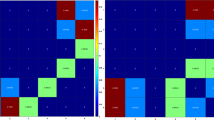Abstract
Latin hypercube designs (LHDs) are very popular in designing computer experiments. In addition, orthogonality is a desirable property for LHDs, as it allows the estimates of the main effects in linear models to be uncorrelated with each other, and is a step** stone to the space-filling property for fitting Gaussian process models. Among the available methods for constructing orthogonal Latin hypercube designs (OLHDs), the rotation method is particularly attractive due to its theoretical elegance as well as its contribution to space-filling properties in low dimensional projections. This paper proposes a new rotation method for constructing OLHDs and nearly OLHDs with flexible run sizes that cannot be obtained by existing methods. Furthermore, the resulting OLHDs are improved in terms of the maximin distance criterion and the alias matrices and a new kind of orthogonal designs are constructed. Theoretical properties as well as construction algorithms are provided.
Similar content being viewed by others
References
Ai M Y, He Y Z, Liu S M. Some new classes of orthogonal Latin hypercube designs. J Statist Plann Inference, 2012, 142: 2809–2818
Efthimiou I, Georgiou S D, Liu M Q. Construction of nearly orthogonal Latin hypercube designs. Metrika, 2015, 78: 45–57
Fang K T, Liu M Q, Qin H, et al. Theory and Application of Uniform Experimental Designs. Singapore-Bei**g: Springer and Science Press, 2018
Georgiou S D, Efthimiou I. Some classes of orthogonal Latin hypercube designs. Statist Sinica, 2014, 24: 101–120
Hedayat A S, Sloane N J A, Stufken J. Orthogonal Arrays: Theory and Applications. New York: Springer, 1999
** R C, Chen W, Sudjianto A. An efficient algorithm for constructing optimal design of computer experiments. J Statist Plann Inference, 2005, 134: 268–287
Johnson M E, Moore L M, Ylvisaker D. Minimax and maximin distance designs. J Statist Plann Inference, 1990, 26: 131–148
Joseph V R, Hung Y. Orthogonal-maximin Latin hypercube designs. Statist Sinica, 2008, 18: 171–186
Lin C D, Bingham D, Sitter R R, et al. A new and flexible method for constructing designs for computer experiments. Ann Statist, 2010, 38: 1460–1477
Lin C D, Kang L. A general construction for space-filling Latin hypercubes. Statist Sinica, 2016, 26: 675–690
Lin C D, Mukerjee R, Tang B. Construction of orthogonal and nearly orthogonal Latin hypercubes. Biometrika, 2009, 96: 243–247
Lin C D, Tang B. Latin hypercubes and space-filling designs. In: Dean A, Morris M, Stufken J, et al., eds. Handbook of Design and Analysis of Experiments. Boca Raton: Chapman & Hall/CRC, 2015, 593–626
McKay M D, Beckman R J, Conover W J. A comparison of three methods for selecting values of input variables in the analysis of output from a computer code. Technometrics, 1979, 21: 239–245
Owen A B. Controlling correlations in Latin hypercube samples. J Amer Statist Assoc, 1994, 89: 1517–1522
Pang F, Liu M Q, Lin D K J. A construction method for orthogonal Latin hypercube designs with prime power levels. Statist Sinica, 2009, 19: 1721–1728
Steinberg D M, Lin D K J. A construction method for orthogonal Latin hypercube designs. Biometrika, 2006, 93: 279–288
Sun F S, Liu M Q, Lin D K J. Construction of orthogonal Latin hypercube designs. Biometrika, 2009, 96: 971–974
Sun F S, Liu M Q, Lin D K J. Construction of orthogonal Latin hypercube designs with flexible run sizes. J Statist Plann Inference, 2010, 140: 3236–3242
Sun F S, Pang F, Liu M Q. Construction of column-orthogonal designs for computer experiments. Sci China Math, 2011, 54: 2683–2692
Sun F S, Tang B X. A general rotation method for orthogonal Latin hypercubes. Biometrika, 2017, 104: 465–472
Wang L, Sun F S, Lin D K J, et al. Construction of orthogonal symmetric Latin hypercube designs. Statist Sinica, 2018, 28: 1503–1520
Wang L, Yang J F, Lin D K J, et al. Nearly orthogonal Latin hypercube designs for many design columns. Statist Sinica, 2015, 25: 1599–1612
Winker P, Fang K T. Optimal U-type design. In: Niederreiter H, Zinterhof P, Hellekalek P, eds. Monte Carlo and Quasi-Monte Carlo Methods. New York: Springer, 1998, 436–448
Yang J Y, Liu M Q. Construction of orthogonal and nearly orthogonal Latin hypercube designs from orthogonal designs. Statist Sinica, 2012, 22: 433–442
Ye K Q. Orthogonal column Latin hypercubes and their application in computer experiments. J Amer Statist Assoc, 1998, 93: 1430–1439
Acknowledgements
This work was supported by National Natural Science Foundation of China (Grant Nos. 12131001 and 11871288), National Ten Thousand Talents Program and the 111 Project B20016. The authors thank the referees for their helpful comments and suggestions. The first two authors contributed equally to this work.
Author information
Authors and Affiliations
Corresponding author
Rights and permissions
About this article
Cite this article
Sheng, C., Yang, J. & Liu, MQ. A new rotation method for constructing orthogonal Latin hypercube designs. Sci. China Math. 66, 839–854 (2023). https://doi.org/10.1007/s11425-020-1996-1
Received:
Accepted:
Published:
Issue Date:
DOI: https://doi.org/10.1007/s11425-020-1996-1




